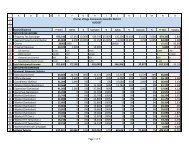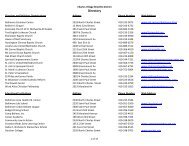Introduction to Robert's Rules of Order
Introduction to Robert's Rules of Order
Introduction to Robert's Rules of Order
Create successful ePaper yourself
Turn your PDF publications into a flip-book with our unique Google optimized e-Paper software.
How are Motions Presented?1. Obtaining the floora. Wait until the last speaker has finished.b. Rise and address the Chairman by saying, "Mr. Chairman, or Mr. President."c. Wait until the Chairman recognizes you.2. Make Your Motiona. Speak in a clear and concise manner.b. Always state a motion affirmatively. Say, "I move that we ..." rather than, "I move that we donot ...".c. Avoid personalities and stay on your subject.3. Wait for Someone <strong>to</strong> Second Your Motion4. Another member will second your motion or the Chairman will call for a second.5. If there is no second <strong>to</strong> your motion it is lost.6. The Chairman States Your Motiona. The Chairman will say, "it has been moved and seconded that we ..." Thus placing yourmotion before the membership for consideration and action.b. The membership then either debates your motion, or may move directly <strong>to</strong> a vote.c. Once your motion is presented <strong>to</strong> the membership by the chairman it becomes "assemblyproperty", and cannot be changed by you without the consent <strong>of</strong> the members.7. Expanding on Your Motiona. The time for you <strong>to</strong> speak in favor <strong>of</strong> your motion is at this point in time, rather than at thetime you present it.b. The mover is always allowed <strong>to</strong> speak first.c. All comments and debate must be directed <strong>to</strong> the chairman.d. Keep <strong>to</strong> the time limit for speaking that has been established.e. The mover may speak again only after other speakers are finished, unless called upon by theChairman.8. Putting the Question <strong>to</strong> the Membershipa. The Chairman asks, "Are you ready <strong>to</strong> vote on the question?"b. If there is no more discussion, a vote is taken.c. On a motion <strong>to</strong> move the previous question may be adapted.Voting on a Motion:The method <strong>of</strong> vote on any motion depends on the situation and the by-laws <strong>of</strong> policy <strong>of</strong> your organization.There are five methods used <strong>to</strong> vote by most organizations, they are:1. By Voice -- The Chairman asks those in favor <strong>to</strong> say, "aye", those opposed <strong>to</strong> say "no". Anymember may move for a exact count.2. By Roll Call -- Each member answers "yes" or "no" as his name is called. This method is usedwhen a record <strong>of</strong> each person's vote is required.3. By General Consent -- When a motion is not likely <strong>to</strong> be opposed, the Chairman says, "if thereis no objection ..." The membership shows agreement by their silence, however if onemember says, "I object," the item must be put <strong>to</strong> a vote.4. By Division -- This is a slight verification <strong>of</strong> a voice vote. It does not require a count unless thechairman so desires. Members raise their hands or stand.5. By Ballot -- Members write their vote on a slip <strong>of</strong> paper, this method is used when secrecy isdesired.







